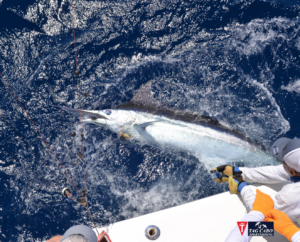Fishing For Blue Marlin
The blue marlin is the national fish of the Bahamas, so naturally, they’re plentiful in the crystal blue waters surrounding the islands. They’re found during the Atlantic Ocean and easily recognized based on their long sword like nose and large blue bodies. Since they’re probably the most famous fish in the Bahamas, catching one, though it might prove difficult because of their strength and size, is extremely rewarding. Description – Marlin are known for their size with the females growing up to 4 times as large as the males. Whilst the larger males usually weighing around 350 pounds, a female can reach up to 1, 810 pounds, just shy of a ton.
They can also grow up to sixteen legs long. In accordance with the International Game Fish Association, the largest one ever caught was 1, 402 pounds, and it was captured in Brazil. Their size and the strength that accompanies it means they’ve to cope with few predators, mainly killer whales and great white sharks. The fish is usually dark blue to cobalt blue on top with a silver white underside, though it can change colours rapidly when it gets excited, usually when eating or mating. They can also have light blue or lavender stripes. Apart from its colour, its long, pointy bill is one of its most recognizable characteristics, as well as high dorsal fin.
Habitat and Migration – Blue Marlins prefer warmer temperatures and usually stay in the tropics regions of the Atlantic Ocean, especially in the waters of the Caribbean and Central and South America, and also the shore of Africa near the equator. Nevertheless, throughout the warmer summertime, they might swim further south or north, depending upon the heat and direction of the ocean currents. Their ideal water temperature is 75 degrees. Tagging research has shown that the fish can travel up to 9, 254 miles. These studies also show that the fish in the Bahamas usually travel back and forth to Venezuela during the year.
They have a tendency to stay close to the surface of the water where temperatures are higher, but they’ll dive deep to catch food. Feeding – The fish have a tendency to feed along coral reefs and oceanic islands that is one of numerous reasons they frequently migrate to the Bahamas along with other Caribbean islands. They feed on fish like tuna, squid, and mackerel, but they aren’t too picky and will eat several small fish or a large fish of up to 100 pounds. The marlin is thought to invade a school and stab at the fish with its long bill. Popularity – Blue marlin fishing was a popular sport for nearly a century. Writer Ernest Hemingway loved to fish for them in the Bahamas and the Florida Keys and even wrote about it in his famous story The Old Man and the Sea.
I hope you found this article interesting if you would like to go fishing for marlin Cabo San Lucas is a great option with marlin all year around.
Contact Tag Cabo Sportifshing to reserve your next fishing adventure.
Follow Us on Facebook to keep up on our live Cabo San Lucas fishing reports.
Subscribe to our you tube channel to watch our fishing adventures.

